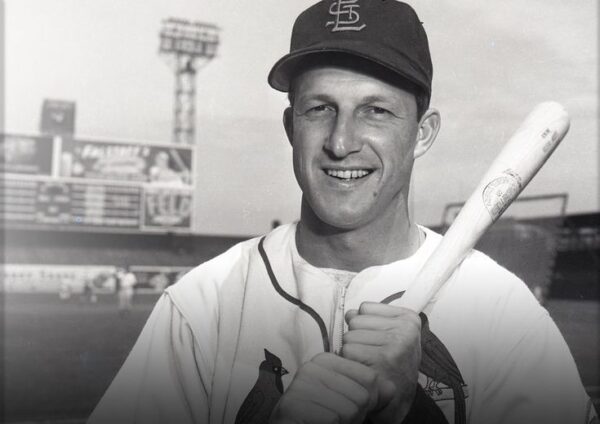 Image Credit-Pinterest
Image Credit-Pinterest
Stan Musial, a name etched in the annals of baseball history, stands as a towering figure whose impact on the game transcends the boundaries of time. Born on November 21, 1920, in Donora, Pennsylvania, Musial’s journey from a small industrial town to the pinnacle of baseball greatness is nothing short of remarkable.
Musial’s impact on the field is woven into the very fabric of the sport. A stalwart of the St. Louis Cardinals, he amassed a staggering 3,630 hits during his illustrious career, etching his name among the all-time greats. His consistency and prowess at the plate earned him the nickname “Stan the Man,” a moniker that resonates with reverence in the hearts of baseball enthusiasts.
As we embark on this exploration of Stan Musial’s legacy, we delve into the records that became synonymous with his name. From his remarkable batting average to the records that still stand, Musial’s achievements paint a picture of a player whose brilliance knew no bounds.
Yet, beneath the statistical marvel lies a series of intriguing questions. Why did Stan Musial not serve in the military? Did he achieve the coveted Triple Crown during his storied career? Join us on this journey as we unravel the layers of Stan Musial’s life, from the diamond to the mysteries that surround his legacy. Get ready to step into the world of a baseball icon whose impact echoes through the corridors of time.
Career Statistics for Stan Musial
| Category | Career Total |
| Batting Average | .331 |
| Hits | 3,630 |
| Home Runs | 475 |
| Runs Batted In (RBIs) | 1,951 |
| Runs Scored | 1,949 |
| Doubles | 725 |
| Triples | 177 |
| All-Star Appearances | 24 |
| Most Valuable Player (MVP) Awards | 3 (1943, 1946, 1948) |
| World Series Championships | 3 (1942, 1944, 1946) |
Early Life and Career
Stan Musial’s journey to baseball greatness began in the close-knit community of Donora, Pennsylvania. Born into a Polish immigrant family on November 21, 1920, Stanisław Franciszek Musiał, later known as Stan Musial, developed a passion for baseball that would shape his destiny.
In his formative years, Musial honed his skills on the sandlots and streets of Donora. It didn’t take long for his prodigious talent to catch the attention of scouts. The St. Louis Cardinals, recognizing the potential in this young phenom, signed Musial to their organization in 1938.
Musial’s early career saw him rise through the ranks, showcasing a natural aptitude for the game. His Major League Baseball (MLB) debut in 1941 marked the beginning of a storied tenure with the Cardinals. As an outfielder and first baseman, Musial’s versatility and skill set him apart.
Notable moments began to punctuate his career, and Musial quickly became a fan favorite. His iconic batting stance, a corkscrew-like twist, became synonymous with his hitting prowess. The 1943 season saw Musial lead the league in multiple batting categories, providing a glimpse of the greatness that lay ahead.
The post-war era witnessed Musial’s ascension to superstardom. In 1946, he led the Cardinals to a World Series championship, earning the first of his three MVP awards. His consistency at the plate was extraordinary, amassing seven batting titles in the 1940s and 1950s.
Stan Musial’s early career laid the foundation for a legacy that would endure for generations. As we delve into his remarkable journey, we witness the emergence of a baseball virtuoso whose impact on the sport was just beginning.
Records and Achievements
Stan Musial’s career is not just a collection of statistics; it’s a symphony of records that resonate through the corridors of baseball history. As we embark on a deep dive into Musial’s records and achievements, we unearth the milestones that define his unparalleled legacy.
- Batting Brilliance: Musial’s prowess at the plate is evident in his impressive batting records. He retired with a career batting average of .331, an emblem of his consistency and mastery. Across his 22 seasons with the St. Louis Cardinals, he accumulated an astounding 3,630 hits, ranking him fourth in MLB history at the time of his retirement.
- Three-Time MVP: Musial’s impact on the game is epitomized by his three Most Valuable Player (MVP) awards (1943, 1946, 1948). These accolades underscore his ability to not only deliver standout individual performances but also elevate his team to success.
- Record-Setting All-Star Appearances: A staple in the All-Star Games, Musial made 24 appearances, a record that held for over four decades. His presence on the All-Star stage became a testament to his enduring excellence and fan admiration.
- Prolific Hitting and Milestones: Musial’s hitting prowess is immortalized in his 1,951 runs batted in (RBIs) and 475 home runs. Beyond the numbers, he achieved historic milestones, including 1,815 runs scored and 725 doubles.
- Impact on Team Success: The Cardinals’ success during Musial’s tenure is inseparable from his contributions. He played a pivotal role in securing three World Series championships (1942, 1944, 1946), cementing his place as a catalyst for team triumphs.
- Legacy Beyond Statistics: Musial’s impact extends beyond the scorecards. His sportsmanship, leadership, and dedication to the game earned him the prestigious Roberto Clemente Award for sportsmanship and community involvement in 1969.
- Analysis of Impact: Musial’s records are not just numerical; they are a testament to the profound impact he had on the sport. His approach to the game, marked by humility and dedication, set a standard for excellence that transcends generations. Musial’s records and achievements form the bedrock of a legacy that continues to inspire and shape the future of baseball.
The Enigma: Military Service
Stan Musial’s baseball brilliance unfolded against the backdrop of a nation at war. As World War II gripped the globe, athletes from various fields, including baseball, answered the call to serve their country. However, Musial’s journey took a different path, sparking curiosity and, at times, controversy.
- Background and Exemption: In 1944, during the heart of World War II, Musial was classified as 4-F by the Selective Service System, rendering him exempt from military service. The classification was based on a medical condition that was deemed disqualifying. While some questioned the legitimacy of this classification, it was determined by the authorities at the time.
- Occupational Deferment: Musial’s work in the St. Louis-based defense industry was another factor that contributed to his exemption. Employed by the Curtiss-Wright Aircraft Company, he was engaged in essential war production work, a role that granted him an occupational deferment. This fueled debates about the fairness of exemptions based on occupational roles in industries critical to the war effort.
- Controversies and Public Perception: The exemption stirred debates and fueled public speculation. Some viewed Musial’s exemption as a pragmatic decision, acknowledging the importance of his contributions to both the baseball field and the war production efforts. Others questioned the fairness of exemptions and whether they were influenced by Musial’s status as a sports star.
- Legacy and Historical Context: In hindsight, Musial’s exemption reflects the complexities of wartime decisions and the challenges faced by both athletes and the nation. The debates surrounding his military service, while persistent at times, should be viewed in the broader context of the era’s dynamics.
- Personal Impact: For Musial, the military exemption was a defining aspect of his wartime experience. While he continued to play baseball, his commitment to the war effort through essential civilian work underscored the multifaceted contributions individuals made during this critical period.
The enigma of Stan Musial’s military service, marked by exemption and public debate, adds layers to the narrative of his life. As we explore this aspect, we aim to understand the complexities of wartime decisions and appreciate the varied paths individuals navigated during a pivotal moment in history.
Triple Crown Pursuit
The pursuit of a Triple Crown in baseball is a rare and coveted achievement, requiring a player to lead the league in three major statistical categories: batting average, home runs, and runs batted in (RBIs). Stan Musial’s career, marked by consistency and excellence, begs the question: Did he attain the elusive Triple Crown?
- Triple Crown Achievements: Stan Musial, despite coming tantalizingly close on multiple occasions, did not secure a Triple Crown throughout his career. However, the proximity to this accomplishment showcases the remarkable seasons where he contended for the crown.
- Near Misses: In the 1940s and 1950s, Musial’s offensive prowess propelled him into the Triple Crown conversation. Notably, the 1948 season saw him leading in batting average and RBIs but falling short in home runs. The 1957 season presented another opportunity, with Musial leading in batting average and RBIs, yet again narrowly missing the home run title.
- Consistent Excellence: Musial’s pursuit of the Triple Crown underscores his consistent excellence as a hitter. His ability to contend for these titles across multiple seasons reflects a level of performance that few players achieve.
- Triple Crown Contenders: While Musial may not have secured a Triple Crown, his impact on the race speaks volumes about his standing among baseball’s elite. The seasons where he contended for the crown are immortalized as testaments to his skill, determination, and influence.
- Legacy Beyond Statistics: Musial’s legacy extends beyond individual achievements. The absence of a Triple Crown does not diminish his stature in the pantheon of baseball greats. His contributions to the Cardinals’ success, his numerous accolades, and his impact on the game solidify his place as an icon.
As we explore Stan Musial’s Triple Crown pursuit, we witness a player who consistently flirted with baseball immortality. The near misses add layers to his narrative, showcasing a career defined not just by statistical achievements but by the enduring legacy of a player whose impact transcends individual titles.
Legacy and Cultural Impact
Stan Musial’s legacy in baseball is not confined to the record books; it is a narrative woven into the very soul of the sport. As we examine his legacy, we uncover layers of impact that extend beyond statistics, defining Musial as more than a player—a cultural icon.
- On-Field Excellence: Musial’s legacy is anchored in on-field excellence. His staggering career statistics and numerous accolades, including 24 All-Star Game appearances, three MVP awards, and three World Series championships, solidify his status among the all-time greats.
- The Humble Champion: Beyond the numbers, Musial’s legacy is characterized by humility and sportsmanship. Known as “Stan the Man,” he endeared himself to fans and opponents alike with his approachability, kindness, and genuine love for the game. Musial’s persona transcended the diamond, making him a revered figure in the baseball community.
- St. Louis Icon: For St. Louis Cardinals fans, Musial is more than a player; he is an enduring symbol of loyalty and connection. His 22-season career, spent entirely with the Cardinals, cements his place as a beloved figure in the team’s rich history.
- Cultural Impact: Musial’s impact extends far beyond baseball diamonds. His cultural significance is evident in the broader American narrative. As a sports icon during the mid-20th century, Musial played a role in shaping the cultural landscape of the era.
- Musial in the Community: Off the field, Musial’s contributions to the community solidified his status as a cultural ambassador. His involvement in charitable endeavors, philanthropy, and community engagement endeared him to people well beyond the realm of sports.
- Remembering Stan the Man: Stan Musial’s passing in 2013 marked the end of an era, but his legacy endures. The outpouring of tributes from fans, players, and the baseball community highlighted the indelible mark he left on the hearts of those who knew him and those who simply admired his legacy.
- Musial’s Enduring Image: The enduring image of Musial, captured in the iconic statue outside Busch Stadium, reflects the reverence with which he is remembered. The statue not only immortalizes his batting stance but also serves as a symbol of inspiration for future generations of baseball enthusiasts.
Stan Musial’s legacy is a multifaceted tapestry woven with threads of skill, humility, and cultural impact. As we reflect on his contributions, we recognize that Musial’s legacy is not confined to a specific era but resonates across time, leaving an indelible imprint on the sport he loved and the hearts of those who continue to celebrate “Stan the Man.”
Stan Musial in Comparison
Comparing Stan Musial with other baseball legends is an exploration of greatness within a constellation of stars. As we delve into this comparative analysis, we highlight what sets Musial apart, making him a unique and enduring figure in the pantheon of baseball history.
- Batting Mastery: In the realm of batting, Musial’s mastery places him alongside legends like Babe Ruth and Ted Williams. His remarkable consistency, highlighted by a .331 career batting average, stands as a testament to his skill and places him among the elite hitters of his era.
- Versatility and Adaptability: Musial’s unique versatility sets him apart. As both an outfielder and first baseman, he demonstrated adaptability, excelling defensively while maintaining offensive excellence. This dual proficiency adds a layer of complexity to his legacy, showcasing a player who contributed on multiple fronts.
- Iconic Stance and Approach: Musial’s iconic batting stance, characterized by a corkscrew-like twist, is etched in baseball lore. This distinctive approach not only contributed to his hitting success but also made him instantly recognizable. Musial’s style became a signature, setting him apart in the visual memory of baseball fans.
- Longevity and Loyalty: His 22-season career, spent entirely with the St. Louis Cardinals, distinguishes Musial for his loyalty and longevity. In an era where player-team relationships were evolving, Musial’s commitment to a single franchise became a rarity, solidifying his connection with Cardinals fans.
- Three-Time MVP and Postseason Impact: While Musial’s three MVP awards align him with the elite, his impact in postseason play adds another layer. Musial’s contributions were pivotal in securing three World Series championships for the Cardinals, elevating his legacy in clutch moments on the grandest stage.
- Off-Field Persona and Legacy: Off the field, Musial’s affable persona and community engagement set him apart. In comparison with some contemporaries, his reputation for humility and accessibility created a lasting legacy that transcended the game.
Comparing Stan Musial with other baseball legends reveals a player whose unique blend of skills, adaptability, and persona sets him apart. Musial’s impact on the field, combined with his distinctive style and off-field contributions, cements his legacy as not just a baseball star but as a player whose influence resonates far beyond the diamond. In the tapestry of baseball history, Stan Musial occupies a singular and cherished place.
Conclusion
In the grand tapestry of baseball history, Stan Musial emerges not merely as a player but as a beacon of enduring greatness. His legacy is an indomitable force, woven with records, accolades, and a distinctive approach to the game. Musial’s impact extends beyond statistics; it is a narrative of loyalty, humility, and unwavering commitment.
As we reflect on his 22-season journey with the St. Louis Cardinals, Musial’s batting mastery, versatility, and postseason heroics come to the forefront. His iconic stance, eternally frozen in time, symbolizes an era of baseball where individuality and skill converged to create legends.
Off the field, Musial’s affable persona and community engagement solidify his status as a beloved figure. His legacy reaches far beyond the diamond, touching the hearts of fans and aspiring players alike.
To truly understand the essence of Stan “The Man” Musial, one must delve into the rich chapters of his career, exploring the records, the anecdotes, and the cultural impact he left in his wake. As we bid farewell to this baseball icon, the invitation stands: Explore more about Stan Musial, unravel the tales, and discover the magic that makes him an immortal force in the annals of America’s pastime. In doing so, we honor not just a player but a legacy that continues to inspire and resonate through the echoes of baseball history.
How much did you like this Pitch Perfect: Deciding Between 4-Seam and 2-Seam Fastballs, please share your view in the comment box, also share this blog with your friends on Social Media so they can also enjoy this blogs for more blogs visit baseballpropicks.com
Related Article –
- WILLIE WILSON: A CLOSE LOOK AT HALL OF FAME CONTROVERSY
- SONNY GRAY: MASTERING THE MOUND IN MLB | CAREER, STATS, AND TEAMS
- ROBERTO CLEMENTE: THE BASEBALL ICON WHO DEFIED HALL OF FAME ODDS

Meet Daniel Anderson, the heart and soul behind Baseball Pro Picks. At 49, Daniel’s life has revolved around baseball, a passion that’s as strong today as it was when he first fell in love with the game. Living in the USA, Daniel has dedicated countless hours to watching, analyzing, and understanding every pitch, hit, and home run, making almost no game missed. His deep-rooted love for the sport is matched only by his commitment to sharing insightful, expert analysis with fellow baseball enthusiasts. With decades of experience and a keen eye for the game’s nuances, Daniel brings a unique perspective that enriches Baseball Pro Picks. Trust Daniel to guide you through the intricacies of baseball with the authority and trustworthiness of a true aficionado.












